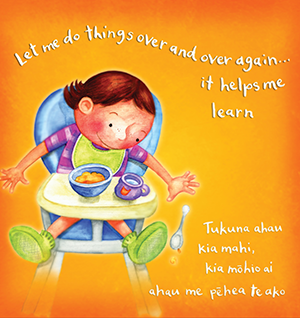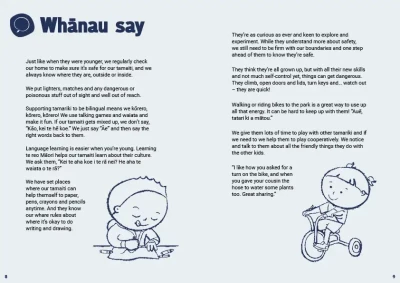
Fine motor skills
Ideas for whānau to help support the development of their child's fine motor skills – muscles in wrists, hands and fingers.
We use fine motor skills to move the small muscles in our bodies, especially those in the wrists, hands and fingers. We also have small muscles in our toes, lips, and tongue.
Tuning fine motor skills
At this stage, parents may be noticing their child ‘fine tuning’ their fine motor skills. They will be getting better at using their hands and fingers and will now find it easier to pick up small objects – to hold and manipulate items like spoons and crayons, or turn pages in books.
Ask whānau:
- What kinds of things have you noticed your tamaiti doing where they’re using the small muscles in their hands and fingers?
In the Whakatipu booklet Te Kōhuri 3 (page 8), Whānau say: “We have set places where our tamaiti can help themself to paper, pens, crayons and pencils anytime. And they know our whare rules about where it’s okay to do writing and drawing."
- What are you happy for them to play with to help develop those small muscles in their hands and fingers?
Using small muscles
Here are some ideas you might like to try.
- Handling play dough develops some important skills. Squeezing and stretching the dough helps strengthen finger muscles, while touching it also provides a valuable sensory experience.
- Using finger paint can strengthen a child’s hand-eye coordination and manual dexterity, and can be a soothing activity. The child needs to be allowed to be messy, so that might require some planning. Find a suitable space, maybe a garage or outside area, and dress them in old clothes so it won’t matter if they get dirty. They’ll need a flat surface, thick paper or card (wallpaper or a cereal box would work) and some finger paints.
- Have they ever experienced finger paint?
- Yes? How did they respond?
- No? Where do you think would be a suitable place for them to have a go at using finger paint?
More ideas
- Having access to crayons, felt tips, chalk, paint, collage materials and glue will give them lots of opportunities to play and scribble.
- Children need free play at this stage. They don’t need to be drawing anything in particular. Just encourage them to draw however and whatever they want. This lets them develop their imagination and skills without any pressure.
- Try to avoid colouring books with pre-drawn images that the child is expected to ‘fill in’. This can frustrate and disappoint them and lead to dissatisfaction with their own abilities.
- If ‘mess’ is a problem for parents, bath time can be a good time for their child to practise using fine motor muscles.
Water games
- What toys or activities do they have in the bath? Small pieces of sponge can be perfect for squeezing in the bath.
- For outside play, they could have two small containers, one filled with water, and the other empty. They can soak up the water using a sponge and transfer the water back and forth between containers. This simple game strengthens hands and forearms. It is especially fun if you throw in some bubbles or some food colouring.
- Another option is to have balls of cotton wool for them to transfer between containers, using small tongs.
Other ideas
- Play ‘your turn, my turn’ by picking up other objects with tongs, like milk bottle tops or buttons (with supervision), and transferring them back and forth. There are two learning opportunities here – they’re practising taking turns and they’re getting ready for using scissors (which use the same small muscles and actions).
- Blocks offer lots of opportunity to play freely, and they’re a great way for little hands to gain strength and control.
Ask whānau:
- What sort of things do you think your tamaiti would enjoy playing with?
Try an activity
Paper chains – Ngā mekameka pepa
Making paper chains means that tamariki can make something that can contribute to whānau celebrations and use and strengthen the fine motor skills used in drawing, cutting and stapling.
Helpful resources for whānau
-
Manipulative play
Ministry of Education
Ideas for manipulative play from the Ministry of Education. Manipulative play refers to activities where children move, order, turn or screw items to make them fit.












